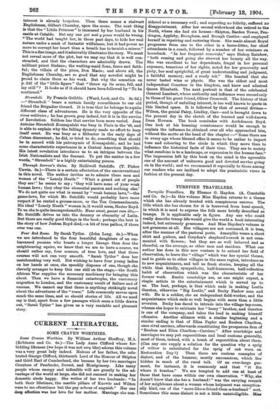C URRENT LITE RAT URE.
SOME CRAVEN WORTHIES.
Some Craven Worthies. By William Arthur Shuffrey, M.A. (Robinson and Co. 6s.)—The Lady Anne Clifford whose for- bidding likeness (we hope it was not very like) adorns this volume was a very great lady indeed. Heiress of her father, the cele- brated George Clifford, thirteenth Lord of the Honour of Skipton and third Earl of Cumberland, she became by her two marriages Countess of Pembroke, Dorset, and Montgomery. Like many people whose energy and inflexible will are greatly to the ad- vantage of the world at large, she did not succeed in making her domestic circle happy. She writes of her two husbands : "In both their lifetimes, the marble pillars of Knowle and Wilton were to me oftentimes but the gay arbour of anguish." Her one deep affection was her love for her mother. Marriage she con-
sidered as a necessary evil ; and expecting no felicity, suffered no disappointment. After her second widowhood she retired to the North, where she had six houses—Skipton, Barden Tower, Pen- dragon, Appleby, Brougham, and Brough Castles—and employed herself in repairing and restoring them. She made almost Royal progresses from one to the other in a horse-litter, her chief attendants in a coach, followed by a number of her retainers on horseback. "In her frequent removals," says Bishop Rainbow, "both coming and going she strewed her bounty all the way. She was excellent to her dependents, frugal in her personal expenses, tenacious of her rights, noted for her generosity and piety, her soul sprightful, of great understanding and judgment, a faithful memory, and a ready wit." She boasted that she never tasted wine or physic. She was the oldest and most independent Countess in the kingdom, and knew and admired Queen Elizabeth. The next portrait is that of the celebrated General Lambert, whose authority and influence were second only to those of his great friend, Oliver Cromwell. The history of that period, though of unfailing interest, is too well known to quote in this limited space. It is followed by that of several divines— Wilson, the genial Paley, Lindley, Carr—and is brought down to the present day in the sketch of the learned and well-known Dean Howson. The book concludes with Archdeacon Boyd. One look at his beaming countenance would be enough to explain the influence he obtained over all who approached him, without the motto at the head of the chapter :—" Some there are in every age whose blessed office it seems to be rather to impart tone and colouring to the circle in which they move than to influence the historical facts of their time. They are to society what sunshine is to a landscape, or expression to the human face:. The impression left by this book on the mind is the agreeable one of the amount of unknown good and devoted service going on in the world ; and we recommend it especially to those among our readers who are inclined to adopt the pessimistic views in fashion at the present day.






































 Previous page
Previous page